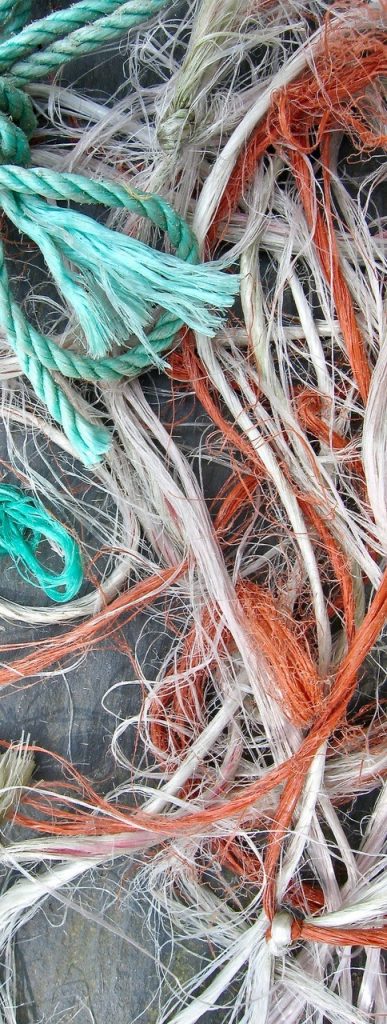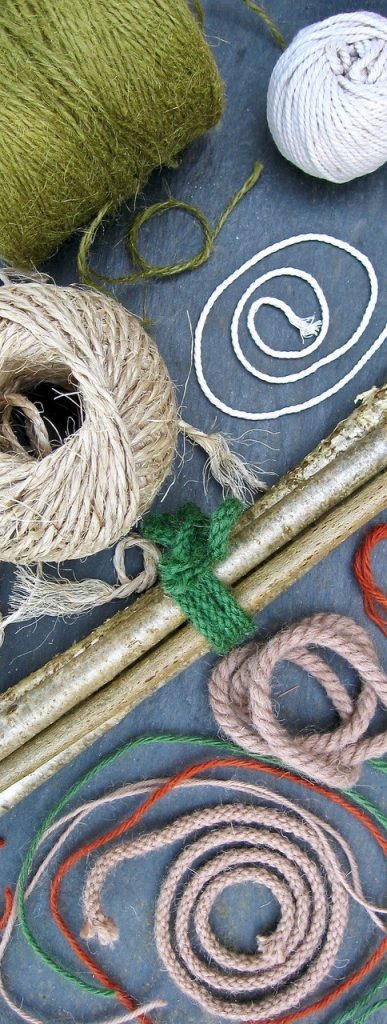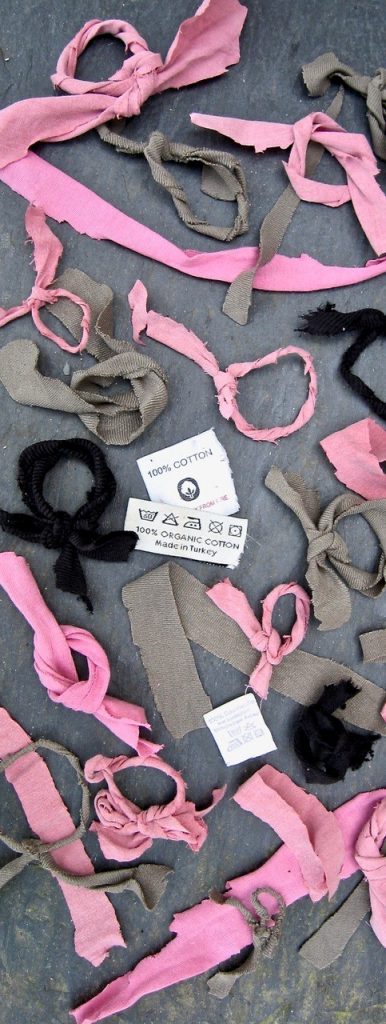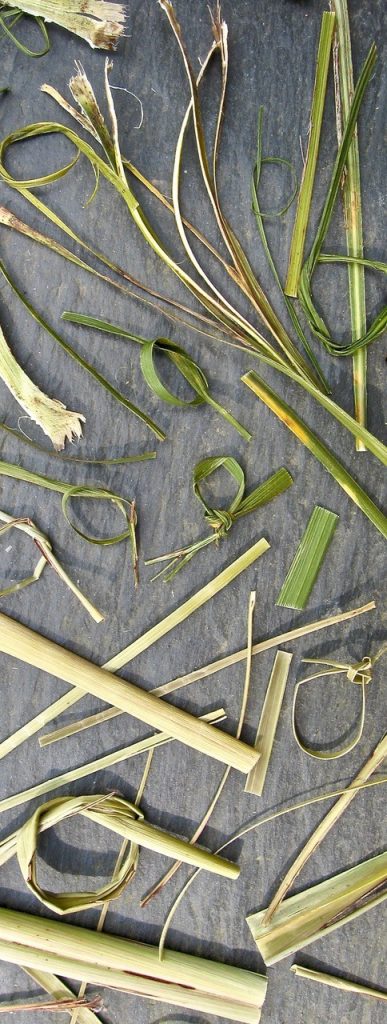Cut your ties to plastic – there are plenty of renewable options that provide plant support without microplastic pollution.
Off they go, carried on the breeze – motes of pink, persistent pollution blowing up and away into our world. A small, shimmering cloud of glinting alien fragments, destination uncertain, their effect on the web of life – and on us – unknown. Given the recent dry easterlies, I’ll hazard a guess on one possible resting place: the summit of Yr Wyddfa (Snowdon), about 8½ miles away – as the raven flies. I set them free, these indestructible, mobile motes, simply by unpicking a fraying knot around some hazel beanpoles in my garden – a knot tied in some old pink baler twine (available in generous quantities, snagged in the farmland hedges of North Wales). It didn’t cost me a penny, this tough plastic string – but my gardener’s penchant for thrifty reuse could, one day, cost us all dear.

At least, that’s what new research led by France’s Ecolab research institute, into global microplastic pollution, is telling us. Not even the most remote and seemingly pristine corners of nature are immune from our plastic litter; tiny airborne fragments have been found to travel in the air for up to 62 miles (100km) – and probably much further. I’m guessing that some of my pink dust has ended up floating in the Irish Sea – or in the soil of the Emerald Isle. Studies have found microplastic debris even in the highest reaches of the French Pyrenees, miles from human habitation. This stuff is everywhere: in our air, our soils, our water, our food… in us. This human-engineered global blight is so ubiquitous, it prompted this warning from an Ecolab researcher: “If it is going to be a problem, it is going to be a very big problem. I don’t think there is an organism on earth that is immune to this.”
So there will be no more polypropylene baler twine for frugal old me – in fact, no more plastic anything here, when it comes to sourcing plant ties and other supports for my greenhouse and garden. This is one vital strand of gardening where we can – overnight – take a meaningful leap closer to earth-friendliness. We don’t need a ‘big debate’ on making this switch; we just need to get on with it. But if you’re clutching a roll of cheap, strong and oh-so-useful green poly twine, don’t panic. Truly ‘green’ options for tying in our tomatoes, roses and runner beans are closer to home than you might think. Some you’ll find at garden retailers (online and off), others could be in your underwear drawer, and you might already even be growing some.

Wire (galvanised steel or copper) is still an eco-friendly option if you need a tougher tie, but avoid wire that’s ‘flexi’ and covered in plastic, foam or rubber. A green coating might look good, but when it eventually disintegrates, you’ll become a microplastic polluter. And anyway, twine and rope made from various natural plant fibres are strong, flexible, easy to use, compostable, renewable and non-polluting. Usually, you’ll find at least one option for sale – amid a sea of plastic – at garden retailers; I was chuffed to find three at a big DIY store, in a range of useful thicknesses (for a wider choice, it’s worth looking beyond the gardening section).
Much familiar twine is made from jute fibre, harvested from a member of the mallow family. It grows in tropical regions and is used in a range of products, including soft but strong plant twine. Tougher still, sisal is made into a multi-use, super-tough twine with a coarse texture. I use it for anything from tying my cordon tomatoes to their hazel stakes, to making it a plant support in its own right. Sisal fibre is stripped from the leaves of Agave sisalana, a tough succulent that’s grown in arid regions such as Mexico. Its fibres resist bacterial damage, making it long-lasting outdoors. Sisal’s also made into rope, carpets – even dartboards.
You probably won’t find hemp twine/string in garden centres, but I did find it online (it’s popular with home crafters). Hemp fibres are extracted from Cannabis sativa, a relative of the stinging nettle. Like jute and sisal, this is an easy-to-grow crop requiring no pesticide or fertiliser inputs, which can be grown organically. Hemp fibre is tough enough to be made into rope, is long-lived, and comes with zero risk of giving you a gardening high – although you’ll definitely get a buzz out of knowing it’s pollution-free.
Cotton twine/string is a good choice for those with daintier fingers. Widely available, it’s soft and easy to tie, making it useful for more delicate plants. The bad news is that most cotton cultivation comes with a whopping, pesticide-heavy footprint. The good news is that certified organic cotton twine is an online search away (a ball of organic cotton yarn will last yonks).

Raffia is a widely available, tried, trusted and – like all natural plant-fibre ties – fully rottable plant-supporting stalwart. Its tough, flat ribbons are extracted from the raffia palm (Raphia sp.), which grows in tropical zones. Soft to the touch, raffia is ultra-versatile; you can split it into thin strands, or bunch several ribbons together for a stronger binding. Raffia won’t last forever, but it’s more than up to a summer season in a greenhouse.
For plant ties made closer to home, wool might be for you. The long-stranded yarn from Whiteface Dartmoor sheep is grown, shorn and then transformed into a Devon-made range of eco-friendly, renewable and compostable garden ties known as Twool. It’s lovely stuff to knot, and comes as a general-purpose twine (green plus other shades), and as a thicker, stronger rope-like tie for securing trees and shrubs (or for tying bundles of hazel poles together).
An old, pure wool jumper, or a pair of threadbare 100% cotton undies, might yield some ultra-frugal, home-found plant supports. Laddered nylon tights and stockings have long been lauded as free and effective plant ties and supports, but we must move on. Nylon is a synthetic plastic, and will micro-pollute in just the same way as other plastics when it breaks down in the sunshine. So grab a pair of old undies (or other pure cotton garment), some scissors, and get snipping. You can cut your ties to suit the job; I find that strips 4-5in long and a half-inch wide work for most tying-in jobs; chunky strips of faded denim will hold roses and shrubs firm.

Cotton is gentle on the fingers, long-lasting, and can be safely fed to your compost bin when it wears out. There’s an important thing to check when you raid your drawers: only use undies with a ‘100% cotton’ label. If it’s not pure cotton, it will almost certainly contain polyester or viscose, which are both synthetic, polluting plastics. Avoid using the seams (they usually contain synthetic stitching), and any elasticated bands. Most socks are mixed fibres, so avoid them too. If it’s organic cotton, your recycled plant ties will earn a shiny green star.
You’ll gain extra brownie points if you grow your own plants to turn into… your very own plant ties. New Zealand flax (Phormium) and cabbage palm (Cordyline australis) both have long, narrow and extremely tough leaves that can be cut to different lengths, and torn into strips thick enough to suit the job. They make some of the best and most natural-looking plant ties, and they tick every box going: ultra-local, easy-growing, perpetually renewing, evergreen, compostable, and free at the point of harvesting (even fading cabbage palm leaves make strong ties). And you’ll get an eco-kick out of simply making them. All you need is scissors.
The wind can blow all it wants; my patch will shed no more minuscule plastic pollution into our air, soils and water. The disintegrating baler twine is bagged up, ready (fingers crossed) for recycling. It’ll be joined by any other non-rotting, blighting plastic – even those part-used ‘go on, keep me!’ rolls. No more soiling of majestic mountains, near and far, with unseen, airborne litter. If this does turn out to be a ‘very big problem’, I want my garden to be part of the solution.
Text and images © John Walker
Find John on Twitter @earthFgardener


